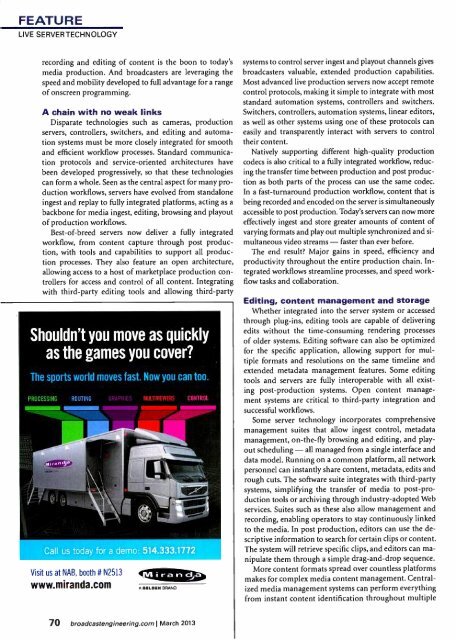ßroadcastEnsineerin - AmericanRadioHistory.Com
ßroadcastEnsineerin - AmericanRadioHistory.Com
ßroadcastEnsineerin - AmericanRadioHistory.Com
You also want an ePaper? Increase the reach of your titles
YUMPU automatically turns print PDFs into web optimized ePapers that Google loves.
March<br />
FEATURE<br />
LIVE SERVERTECHNOLOGY<br />
recording and editing of content is the boon to today's<br />
media production. And broadcasters are leveraging the<br />
speed and mobility developed to full advantage for a range<br />
of onscreen programming.<br />
A chain with no weak links<br />
Disparate technologies such as cameras, production<br />
servers, controllers, switchers, and editing and automation<br />
systems must be more closely integrated for smooth<br />
and efficient workflow processes. Standard communication<br />
protocols and service -oriented architectures have<br />
been developed progressively, so that these technologies<br />
can form a whole. Seen as the central aspect for many production<br />
workflows, servers have evolved from standalone<br />
ingest and replay to fully integrated platforms, acting as a<br />
backbone for media ingest, editing, browsing and playout<br />
of production workflows.<br />
Best -of -breed servers now deliver a fully integrated<br />
workflow, from content capture through post production,<br />
with tools and capabilities to support all production<br />
processes. They also feature an open architecture,<br />
allowing access to a host of marketplace production controllers<br />
for access and control of all content. Integrating<br />
with third -party editing tools and allowing third -party<br />
Shouldn't you move as quickly<br />
as the games you cover?<br />
The sports world moves fast. Now you can too.<br />
PROCESSING ROUTING MUITNIEWLNS CONTROL<br />
Call us today for a de<br />
Visit us at NAB, booth # N2513<br />
www.miranda.com A BRAND<br />
systems to control server ingest and playout channels gives<br />
broadcasters valuable, extended production capabilities.<br />
Most advanced live production servers now accept remote<br />
control protocols, making it simple to integrate with most<br />
standard automation systems, controllers and switchers.<br />
Switchers, controllers, automation systems, linear editors,<br />
as well as other systems using one of these protocols can<br />
easily and transparently interact with servers to control<br />
their content.<br />
Natively supporting different high -quality production<br />
codecs is also critical to a fully integrated workflow, reducing<br />
the transfer time between production and post production<br />
as both parts of the process can use the same codec.<br />
In a fast -turnaround production workflow, content that is<br />
being recorded and encoded on the server is simultaneously<br />
accessible to post production. Today's servers can now more<br />
effectively ingest and store greater amounts of content of<br />
varying formats and play out multiple synchronized and simultaneous<br />
video streams - faster than ever before.<br />
The end result? Major gains in speed, efficiency and<br />
productivity throughout the entire production chain. Integrated<br />
workflows streamline processes, and speed workflow<br />
tasks and collaboration.<br />
Editing, content management and storage<br />
Whether integrated into the server system or accessed<br />
through plug -ins, editing tools are capable of delivering<br />
edits without the time -consuming rendering processes<br />
of older systems. Editing software can also be optimized<br />
for the specific application, allowing support for multiple<br />
formats and resolutions on the same timeline and<br />
extended metadata management features. Some editing<br />
tools and servers are fully interoperable with all existing<br />
post -production systems. Open content management<br />
systems are critical to third -party integration and<br />
successful workflows.<br />
Some server technology incorporates comprehensive<br />
management suites that allow ingest control, metadata<br />
management, on- the -fly browsing and editing, and play -<br />
out scheduling - all managed from a single interface and<br />
data model. Running on a common platform, all network<br />
personnel can instantly share content, metadata, edits and<br />
rough cuts. The software suite integrates with third -party<br />
systems, simplifying the transfer of media to post -production<br />
tools or archiving through industry- adopted Web<br />
services. Suites such as these also allow management and<br />
recording, enabling operators to stay continuously linked<br />
to the media. In post production, editors can use the descriptive<br />
information to search for certain clips or content.<br />
The system will retrieve specific clips, and editors can manipulate<br />
them through a simple drag- and -drop sequence.<br />
More content formats spread over countless platforms<br />
makes for complex media content management. Centralized<br />
media management systems can perform everything<br />
from instant content identification throughout multiple<br />
70 broadcastengineering.com<br />
I<br />
2013
















